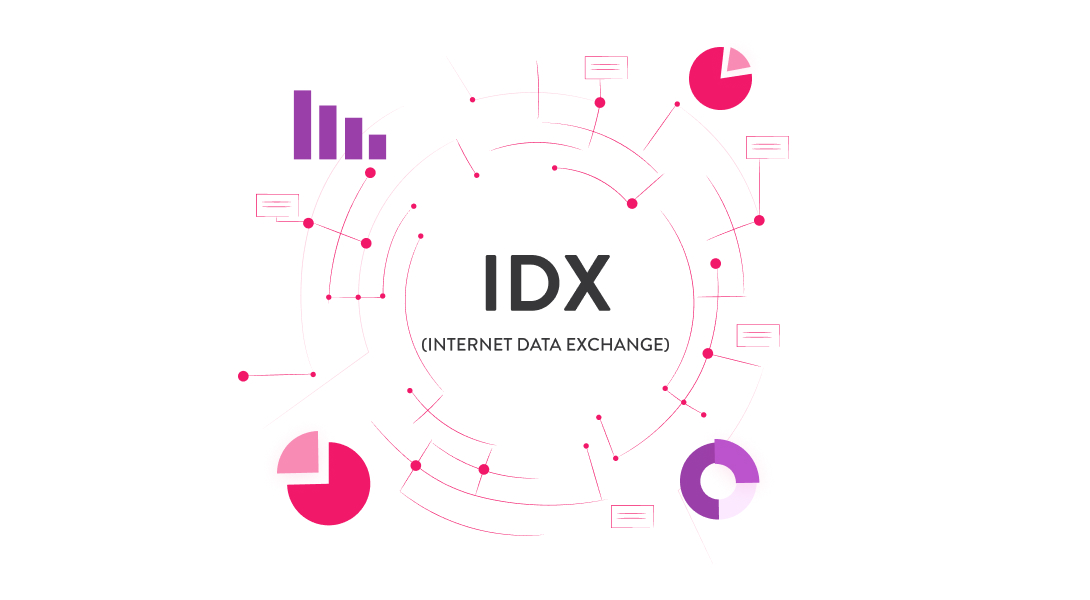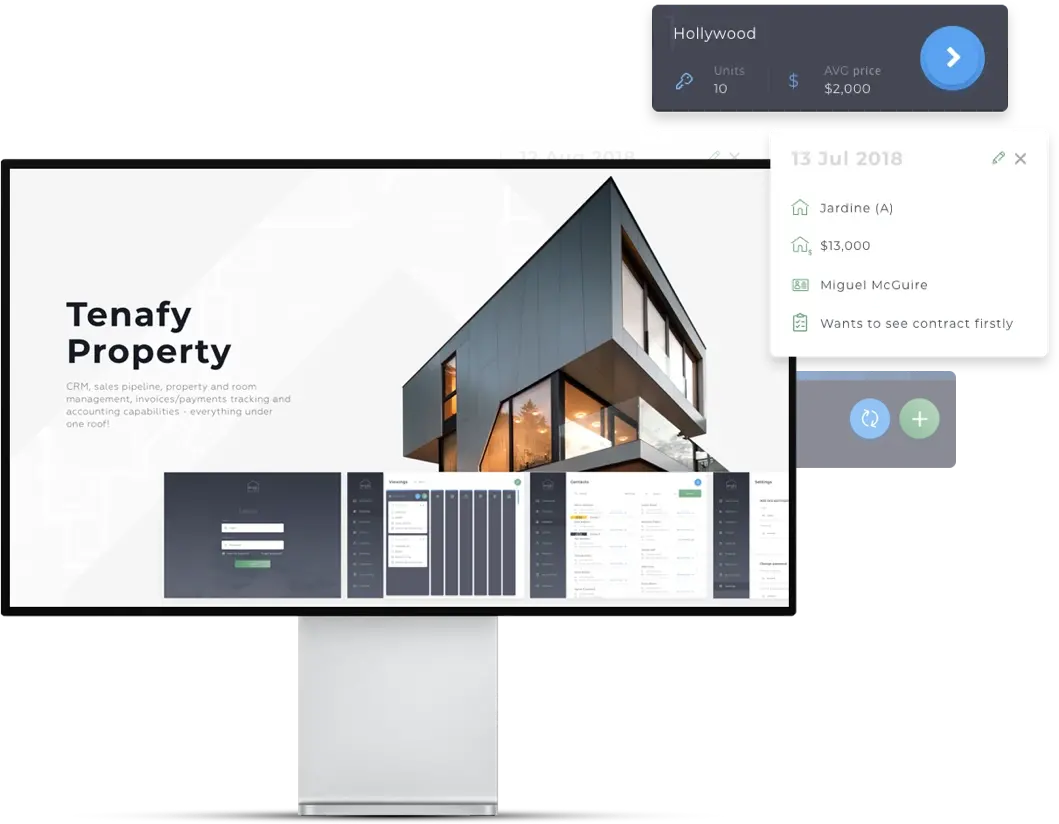The emergence of online resources in the real estate market has triggered a phenomenal surge in sales. Today, both site owners and users reap the benefits of new data exchange technologies through the World Wide Web.
Integration through IDX allows for listing, searching, and purchasing properties globally in real-time. As a result, agents and buyers now connect virtually through video calls. Properties registered in Multiple Listing Service (MLS) databases become accessible to a wider audience, simplifying the search process. This convenience and efficiency make IDX a pivotal solution in the industry.
At Requestum, we boast extensive experience in creating such platforms and are eager to share our insights. In this article, you'll discover why IDX realty websites are so popular and how the IDX real estate website development process unfolds.
What is IDX?
Behind the acronym lies the intricate process of Internet Data Exchange, which runs on various policies, standards, protocols, and data formats for synchronization, compatibility, and interaction between different applications and systems. The Real Estate Transaction Standard (RETS) is the most common protocol underlying IDX-based resources made specifically for realty management.

The system built upon a real-estate-enabled IDX foundation lets you list multiple properties at once like a breeze, allowing you to provide the maximum possible range of offerings. The RETS standard also introduces specialized features and buyer engagement tools, enhancing business visibility online. Furthermore, you can easily update even an extensive info catalog in real-time.
All in all, we have three major approaches to integrating IDX:
-
Framed IDX solutions - When you embed listings directly on an agent's website using HTML iframes. It’s quite easy to set up but can be limited in terms of real estate-associated Search Engine Optimization (SEO) and user convenience.
-
RETS-based IDX solutions - A more advanced solution offering improved SEO and expanded integration. However, it requires greater technical expertise and can be expensive to maintain.
-
Real Estate Standards Organization (RESO) web API-based IDX solutions - The most modern and cost-effective method. It provides a standardized approach to data access, faster updates, and improved scalability.
Explore the future of real estate with generative AI
IDX service pricing is set by MLS boards and third-party providers (such as IDX Broker, Placester, and many others). Generally, basic services are free, with premium features coming for an additional fee.
IDX software is growing in demand faster than we all anticipated. Experts predict that the growth rates of this market segment will persist and increase further until at least 2031. Other statistics say that over 40% of real estate buyers and tenants search for homes online. Data also confirms that homes listed in MLS sell for 3.7% more than others.
Best IDX Real Estate Website Examples
Among the vast number of websites running on the IDX technology, it's challenging to pinpoint the most beautiful and functional ones. But we pick to highlight the cases below relying purely on our own specialized experience.
Zillow
Zillow is one of the leaders in the U.S. real estate market. With its user-friendly interface, extensive search parameters, and a good chunk of information available on all listed properties, the site attracts over 7 billion visitors each year. Created on Wix, which is considered one of the best web development frameworks.
Zillow's main advantages include:
- A massive buyer audience
- National coverage
- High brand recognition
- Reliable mobile applications
Zillow has become popular for a range of life-simplifying features, such as quick property familiarization, detailed characteristics and history, convenient insights into local housing prices, demographic data about the neighborhood, and proximity to schools.
Realtor.com
Directly managed by NAR (National Association of Realtors), Realtor.com serves over 100 million monthly visitors. The site provides broad coverage of real estate and claims to be the largest specialized resource in the U.S. In 2016, Morgan Stanley valued it at $2.5 billion, and its advertising campaigns received accolades from Adweek and Webby Awards.
Key merits of Realtor.com include:
- Excellent national visibility
- A built-in lead generator
- Customizable profiles
While ensuring absolute visibility into many regional realty markets on its own, especially when expanding your profile, we recommend integrating it with your own website to boost sales.
Redfin
Redfin, with its excellent online tools and agent services, attracts over 44 million visitors per month. As a brokerage resource, it offers outstanding search tools, and many users consider its design simply perfect.
Redfin's main advantages include:
- National coverage
- Innovative features like 3D tours
- Flexible service packages
Redfin's business model is based on relatively small commissions, making it quite popular among novice agents.
What can you get if you build an IDX real estate website?
The reasons are plenty. For one thing, IDX provides a sturdy foundation that helps you leverage competitive advantages such as:
- The ability to post more listings with enhanced visibility and trustworthy content.
- Increased sales due to visitors not having trouble searching for offers on their own.
- Expansion of the audience with adaptive design.
Another advantage for you will be integration with marketing tools and CRM systems. Thanks to such innovations, you get more ways to perfect sales strategies and boost your revenue numbers.
Tenafy Case Study: Streamlining Property Management Digitally

IDX Real Estate Website Development Process
To get traffic, you need to make a real estate website that is user-friendly, and high-performing. To avoid common mistakes and push a sought-after product, you'll need to study the market and competitors. Your site should be intuitive and to the point and motivate purchases. The product/service catalog should be equipped with a good set of filters. Then, there are design, usability, and content.
To make things easier for you, here’s a 7-step “blueprint” to help you develop an IDX real estate website the right way.
Step #1. Register a domain
Make sure to keep your domain name simple and striking, reflecting the whole point of your brand. You can entrust the domain registration to reputable resources like GoDaddy or NameCheap, which often provide extra services such as web hosting and the generation of email addresses associated with the new domain.
Step #2. Choose a web hosting plan
Your hosting foundation directly affects your future website's speed, security, scalability, and performance. You need an option with enough storage and RAM to store large volumes of indexed data coming in from different locations. We recommend A2 Hosting or Hostinger.
Consider the type of web development platform you plan to work with. If it's WordPress, make sure to go through all available managed plans. Look into server-level caching options like Memcached or RedisCache. Also, consider advanced features such as proactive scanning and malware removal to further reinforce your site's security.
Step #3. Use a website builder
WordPress is very user-friendly and doesn't require special knowledge. You can use tons of available themes and plugins, and it serves as a Content Management System (CMS). It's a perfectly mature solution for your first-time site-building.
Other builders like Wix, Weebly, or uKit offer domain names and hosting out of the box. For something more innovative, check out Weblium, which runs on artificial intelligence. In the long run, it all comes down to a pricing plan that matches your budget and provides the best return on investment.
Move on to personalized settings to make your site more striking. Showcase IDX and IDX Central are some of the standing-out providers offering a range of customization options that you can adapt to your users' requirements.
Step #4. Add features
Advanced functionality is the key to successful lead generation. Numerous filters will help better cater to the user. Integration of map-based search can be done through IDX Broker or Placester. The site should be optimized for various platforms and devices. Responsive themes in WordPress help achieve this automatically. We also recommend adding a blog.

It's also crucial to include contact forms on every page. Furthermore, fast integration with social media allows visitors to learn more about you and interact with you on different platforms.
Actively promoting listings on social media will increase the visibility of IDX-integrated pages. As for the blog, posts about the local market situation, communities, and practical tips will enhance your online authority and attract more potential clients.
Step #5. Include IDX-based listings
IDX listings can greatly help grow the value of your online presence. With a reliable provider, you'll get access to MLS listings directly from your website, seriously boosting the overall performance.
With a good provider in hand, you won't have to worry about server or software maintenance. You can focus on marketing, web traffic, and conversions. When integrating stuff, consider how quickly and efficiently a specific technology works with search filters and contact forms.
Step #6. Add content and additional services
Provide customers with relevant and comprehensive information they may need, highlighting all the advantages of the offered real estate. The quality of content decides a lot. Descriptions should be captivating but not overly lengthy or intrusive. Use email marketing (e.g., via MailChimp or Constant Contact) and SEO optimization for headlines.
Add easily distinguishable buttons to listings with mortgage calculators, agent calls, etc. Strive to place calls-to-action near places where potential buyers might find themselves pondering choices (like “buy” buttons or a shopping cart page). Use virtual tours or 3D real estate views that provide a positive user experience to add some icing to the cake.
Let’s create your next software solution
Step #7. Use analytics for monitoring and boosting IDX performance
When figuring out how to create an IDX real estate website, you need to find a provider that offers an easy-to-use solution and reliable technical support at once. You need to efficiently maintain your online resources and get help when needed.
Monitoring the performance of IDX integration is a must if you are looking to enhance the user experience over time and meet the needs of your target audience at all times.
Thorough website analytics will give you information on traffic numbers, user demographics, most viewed properties, bounce rates, and conversion percentages. You can identify areas for improvement and make necessary adjustments to continue providing high-quality services.
Smart Ways to Get More Leads from Your Real Estate IDX Website
After completing your IDX real estate website, the next step is turning it into a steady source of leads. A well-thought-out real estate IDX web design connects you with people who are actively searching for homes. Below are a few practical ways to help your IDX website reach more visitors and inspire them to get in touch.
Promote your IDX website regularly
Your website is one of your strongest marketing tools, but it needs visibility to work. Share it across your social media pages, real estate groups, and community channels. Add the link to your business cards, email signature, and professional profiles, or your local real estate association website. Every mention helps more potential clients find you and your listings.
Offer helpful resources for visitors
People are far more likely to share their contact details when they receive something useful in return. Create straightforward guides or checklists for your audience. For example, a homebuyer’s guide, a step-by-step plan for selling, or a short resource about buying a home in your city. These simple tools make your real estate website development efforts more effective by showing visitors that you understand their needs and can help them through the process.
Keep improving your website over time
Even the most appealing real estate websites IDX benefit from small, steady updates. Track visitor behavior using tools like Google Analytics or Search Console to learn which pages draw the most attention and which ones might need clearer messages or simpler forms. Treat your IDX real estate website as a project that evolves with your experience — the more you refine it, the better it will perform.
Consistent effort and thoughtful adjustments will help your real estate IDX website design stay relevant, attract more visitors, and turn your online presence into a reliable channel for new leads.
Bottom Line
IDX is the tech foundation to help you optimize real estate business operations for an online medium and hit the spot for potential customers online. Adhering to best practices in IDX optimization will help enhance your online presence and attract buyers. But be sure to let only true professionals put their touch on your future website.
Our team will be happy to assist you. We have a firm grip on all the necessary IDX tech and years of experience implementing it. Reach out and find out how you can create the best IDX real estate website at an optimal cost!
Frequently Asked Questions
IDX, or Internet Data Exchange, is a system that allows real estate professionals to display up-to-date listings directly on their websites. It connects with the Multiple Listing Service (MLS) and automatically transfers property data to the website’s display plug-in. This connection keeps listings current and gives potential buyers a convenient way to explore available homes. For many real estate websites with IDX, this feature is the core of their online presence.
People often browse homes on their phones, which makes mobile optimization a key part of modern web design. A mobile-friendly website loads quickly, adapts to different screen sizes, and allows users to explore listings without frustration. A smooth experience keeps visitors engaged and more likely to reach out for details or schedule a viewing.
Security and compliance protect both your business and your clients. The first step is adding an SSL certificate to encrypt user data and create a trusted browsing environment. It’s also important to stay informed about local real estate regulations and industry standards. Reliable IDX solutions for realtors often include built-in safeguards to help you maintain compliance as technology and requirements evolve.

Our team is dedicated to delivering high-quality services and achieving results that exceed clients' expectations. Let’s discuss how we can help your business succeed.


SHARE: